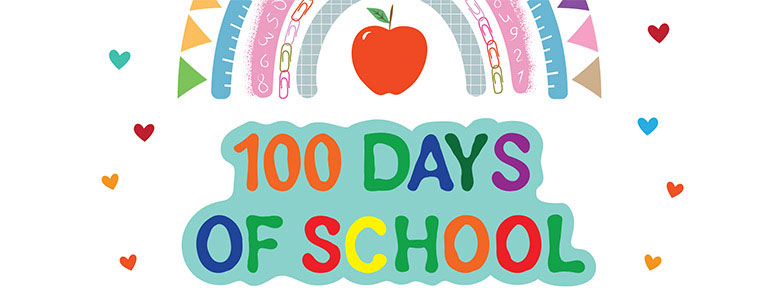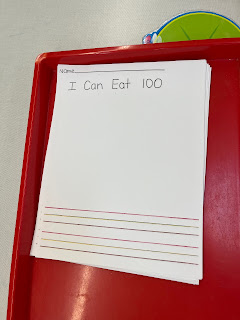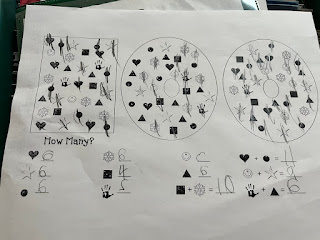100th Day of School

Universal Design for Learning describes the how of learning is seen when students take part and express their thinking. (The IRIS Center, (2009, 2023))
This past week, we celebrated our 100th day of school. The teachers and students dressed up as 100 year olds to mark the occasion. Though the costumes had little to do with learning, they were made as a visual to emphasize the great amount of learning the students had accomplished over the past 100 days in school.
** To note, we did not do any formal social studies or science lessons this week. However, I did see UDL strategies all week.
The IRIS Center says the 'purpose of UDL is to reach every student and develops learner agency' (The IRIS Center, (2009, 2023), p. 1). Had you stepped into our classroom on the 100th day, you would have seen UDL happening all day. My mentor teacher prepared writing, reading, and math activities that were designed to give choice and practice opportunities to each student. For some of our most fragile friends, it was amazing to witness their agency and motivation to show and use their skills.
We started the day with a writing prompt:
100 days ago, I didn't know_________ but now I do!
When considering UDL and the various methods teachers can use to make learning accessible, I saw my mentor teacher use the following instructional methods:
Questioning. When a teacher uses this method, utilizing adequate think time and nonverbals such as pointing to prompts or prompting in general, which is needed in Kindergarten, the students engage with their learning to greater degrees. With these question and answer activities, the students were better able to commit knowledge to memory as well.
The teacher began her writing lesson by asking the students to think back to the first day of school. They were asked to think about what they didn't know then that they know now. Some shared their ideas out to the class. Then they were asked to pair-share with their carpet partners. After that, they went back to their tables to complete the writing prompt. I was so surprised by the motivation, especially from our fragile friends who usually struggle with motivation and attention during writing time. They were incredibly excited to write about all the things they have learned in school. Their motivation reminded me the Independent Practice method teachers utilize to promote autonomy. The writing worksheet was also set up as a graphic organizer. Students had to write first and then draw their pictures, but for some, drawing first helped with their planning and thinking.
**I was so busy helping the students with this writing prompt that I was unable to take photos of them working.
~~
Supports given to our fragile friends during writing:
1. We say the word, tap out each sounds and then say each sound again to help identify and write the letter. This supportive strategy is very important for students who are still learning to hear the letter sounds and remember how they are written.
2. For our student with an IEP for autism, I assisted his writing by writing the sentence starter for him in light blue highlighter marker. He then traced the words and then with assistance, he completed the prompt.
3. We use alphabet cards for the students to access as they write their letters as well.
~~
The students continued their Independent Practice during Literacy Centers when they had a variety of worksheets to choose from to showcase their learning over the last 100 days. Many of the worksheets practiced counting and writing to 100, while others prompted the students to answer questions.
My 100 Day Wish List- I wish I had 100... I do not want 100...
If I had $100, I would buy_________because___________.
I Can Wat 100___________.
When I'm 100, I will look, live, like to eat, like to watch, for fun I will__________.
During Math Centers, the Kindergarteners practiced counting and writing to 100 again, and though it wasn't a dedicated science lesson, I did see some of the 5 E's enacted during a center where the students weighed bags of 100 things. Each student brought in a bag of 100 things. We saw, 100 Cheerios, marshmallows, legos, jelly beans...etc. The teacher invited two students up with the bags, one with beads and the other with chocolate chips. She asked the students which one they thought weighed more. (The Engage phase). The kids delighted in thinking about which bag of 100 things weighed more. During Math Centers, the students had a chance to test their theories (the Explore Phase) and weigh their bag against their friends bags. The students moved into the Explain phase where they talked about whose bag weighed more and wrote down their answers on a worksheet.
Another fun activity that promoted Independent Practice was the snack bag of 100. We had 10 plates of different snacks. The students had to use careful counting and add 10 of each snack to their bag. Not only was this fun and built anticipation, it was a great opportunity to solidify learning using real objects they could eat once the task was complete.
Inclusive education means the integration or inclusion of all students in the same classrooms and in the same schools, without exception. )
Bisio, K. (2022, November 29)
My mentor is always planning with inclusivity in mind. With our visually impaired student, all materials used are adapted so the student can participate and learn alongside his peers. The Special Education teacher uses many strategies such as preparing worksheets with braille, capturing his answers verbally and then writing them down and holding him accountable to his own learning. For our 100 days of school activities, the student was able to participate in every activity of his choosing as they were all made accessible to him.
~~
The IRIS Center, presented another teaching method called Cooperative Learning that I not only see daily, but facilitate alongside my mentor teacher during Literacy Centers or math groups. Cooperative Learning is described as intentional grouping of students to enhance learning (The IRIS Center, (2009, 2023), p. 6). For Literacy Centers, my mentor teacher has grouped students by ability and learning needs. She and I discuss learning targets prior to each lesson as needs vary between groups. Here is a picture of me working with one of our literacy groups. As we read a story, we looked for certain story words.
References
Bisio, K. (2022, November 29). Why inclusive practices are essential in education - MSU Denver. MSU Denver. https://www.msudenver.edu/why-inclusive-practices-are-essential-in-education/
The IRIS Center. (2009, 2023). Universal Design for Learning: Designing Learning Experiences That Engage and Challenge All Students. Retrieved from https://iris.peabody.vanderbilt.edu/module/udl/















Wow Anna, this is a packed and detailed post. Thanks for the details, I saw many ideas in here that I want to do with my class on our 100th day of school.
ReplyDeleteIt seems that your teacher constantly takes UDL into account, even if she doesn't do it consciously or under the term UDL. I think it's amazing that she is able to include so many supports, because as a teacher, there are so many pieces to keep track of without adding supports.
I noticed how you made connections to previous weeks, such as the 5Es of science, even though there were no formal science or social studies lessons this week. I hadn't previously thought about applying those to other areas of the classroom.
Thanks, Chava. I did read your comment weeks ago and just wanted to so thank you. Yes, we do tons of UDL in our classroom do to our diverse group of learners. We have some above grade level and some kids who are at below level, along with some special needs kids. The teacher I am with is incredibly thoughtful in her planning.
DeleteIt sounds like such an fun 100th day celebration!
ReplyDeleteI love how UDL was intentionally embedded throughout the activities, giving students multiple ways to express their learning and engage with the content. The writing prompt was a great way to encourage reflection while also providing the right level of support for all learners. The hands-on math activities, like weighing different bags of 100 items and the snack bag activity, seemed like a fantastic way to incorporate inquiry-based learning and number sense, while also making it fun and festive for the 100th day.
It's also wonderful to see how inclusivity was prioritized, ensuring that every student, even those with visual impairments, had full access to the activities. Your mentor teacher's approach and dedication to planning with accessibility is inspiring!
How did students respond to the weighing activity? Were there any surprising observations or discussions that came up during the explain phase?